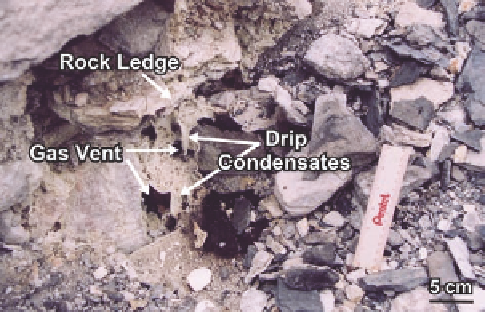Geology Reference
In-Depth Information
Figure 9.1.2. GLS process suggested by unidentified
on a rock ledge overhanging a gas vent at
the Centralia mine fire, Pennsylvania. The drip texture suggests that a gas component exhaled from the vent
condensed to a liquid that subsequently solidified. Photo by Glenn B. Stracher, 2005.
“
drip condensates
”
textural evidence from scanning electron microscope (SEM) images revealed that a more complex sequence of
events occurred. These included condensation, hydrothermal alteration and crystallization from solution, fluctuat-
ing vent temperatures, boiling, and dehydration reactions. Consequently, it is possible that minerals originally
described as sublimates may have formed by one or more complex thermochemical process.
Gas-Liquid Solidification (GLS) occurs when a gas component first condenses to a liquid and then as cooling
continues the liquid solidifies. Drip (stalactite) and flow (ripple) textures observed on rocks overhanging gas vents
or on nearby rock facings are evidence for GLS (Figure 9.1.2). Because they resemble dripstones and flowstones
found in caves, mineral assemblages with drip and flow textures are aptly called drip condensates and flow
condensates, respectively. An isochemical GLS process is represented by the exothermic reaction
Condenses
Solidifies
X
ð
g
Þ !
X
ð
l
Þ !
X
ð
s
Þ
ð
9
:
1
:
2
Þ
where X(l) designates an element or compound in the liquid state.
Mass Transfer Mineralization
M
ineralization processes at coal-fire gas vents that involve mass transfer are more complex than isochemical ones.
These include a variety of reactions, likely more common than previously documented, based on field evidence and
laboratory observations as discussed next.
Gas-Altered Substrate (GAS) occurs when a hot gas component(s) exhaled at a vent reacts with the substrate and
alters it (Figure 9.1.3). This process is analogous to pneumatolytic alteration associated with igneous activity.
Consequently,
Reacts with
substrate
X
ð
g
Þ !
Altered substrate
-
Y
ð
g
Þ"
ð
9
:
1
:
3
Þ
where Y(g) is the composition of the remaining gas. Clinker, rock baked and oxidized by combustion, is suggestive
of GAS or other substrate-altering processes, as discussed below.
Gas-Liquid-Altered Substrate (GLAS) occurs when a liquid condensed from the gas reacts with the substrate and
chemically alters it, resulting in the crystallization of minerals on the altered substrate. For example, if a liquid



